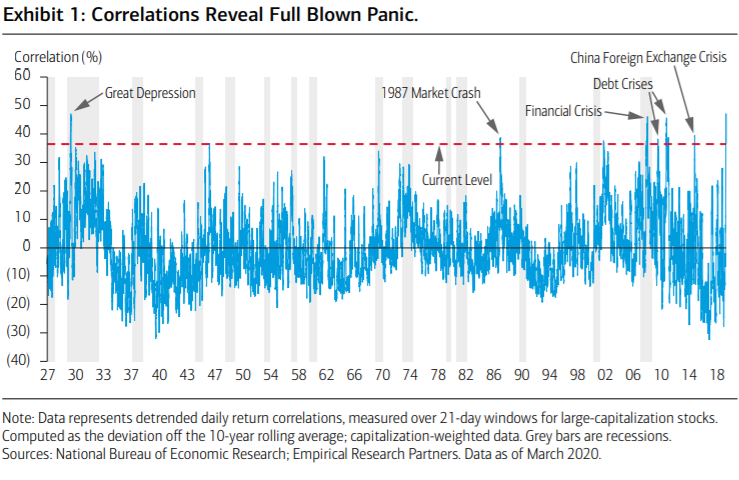Merrill Lynch har analyseret de største recessioner de seneste 100 år og kommer til det resultat, at coronakrisen – økonomisk – kan ende hurtigere, end mange venter. Mange er grebet af panik, men hvis politikerne og centralbankerne griber rigtigt ind, kan krisen ende hurtigere end finanskrisen og depressionen, nemlig som krisen efter markedskrakket i 1987 endte. Det skyldes, at coronakrisen skyldes et pludseligt opstået problem, og at der ikke er en bagvedliggende svækkelse af økonomien. Denne krise er anderledes. Vi synes at have lært noget, skriver Merrill.
Uddrag fra Merrill:
MACRO STRATEGY
What’s Different This Time
The unprecedented coronavirus panic and economic shutdown have precipitated extreme
financial-market reactions only seen in previous crises such as in 2008–2009 and
1929–1933. For example, return correlations of large-capitalization stocks (Exhibit 1)
as measured by analysts at Empirical Research Partners rose to levels a bit above those
seen in the Great Financial Crisis (GFC) of 2008–2009 and only matched by those
observed at the beginning of the Great Depression. In short, the coronavirus selloff
compares with the other two greatest financial panics of the past 100 years. When
correlations are so high, it means there’s indiscriminate selling of everything—good and
bad—as in “throwing out the baby with the bathwater.”

Inevitably, the enormity of what has happened in financial markets has prompted
comparisons with the aftermath of the Great Depression collapse. This has led some
prominent money managers and strategists to warn that “a prolonged period of hard
times and new lows in equity prices is ahead.” This is possible, but not necessarily
inevitable. The outcomes ahead will depend on the particular circumstances of our
current problems and, importantly, on how policymakers respond to them. When we
assess both the nature of the problem and the mitigation policies being applied,
we conclude that the coronavirus bear market will eventually turn out to be more
comparable to the 1987 bear market than that of the Great Depression.
The S&P 500 peaked at about 336 on August 25, 1987, and was relatively flat until early
October, when it began to fall and then collapsed on October 19, 1987, in the biggest
one-day percentage drop ever seen. Almost all the 33% decline occurred between
October 5 and October 19. Similarly, the S&P 500 recently peaked just shy of 3,400 in
the third week of February 2020 and fell to a low near 2,200 on March 23 for a decline
also of about 33%. Both declines were unusually fast, and, as shown in Exhibit 1, the high
correlation observed in 1987 also almost matches the correlation observed in the current
bear market, a key metric of widespread panic.
Most economists predicted a recession would occur after the 1987 drop in equity
prices. Instead, a quick policy response and a strong underlying economy defied their
predictions and the secular bull market resumed, although it took the better part of the
next two years to set a fresh S&P 500 record high.
The 1987 experience was unusual in a couple of respects. First, most bear markets are
preludes to recessions. However, the 1987 drop, especially its speed, was caused by
new financial technology, in particular the use of “portfolio insurance,” which the Brady
Commission investigation of the crash primarily blamed for the unprecedented nature of
the October 19 collapse.
The 2020 stock-market collapse is similarly the result of a one-off factor rather than
reflecting a buildup of pre-recession weaknesses. The U.S. economy was strong when
the government response to the pandemic brought it to its knees. Indeed, the Atlanta
Fed’s GDPNow estimate for the first quarter was tracking around 3% up until the
middle of March. As in 1987, there was a specific, exogenous cause for the extremity
of the selloff. Moreover, the cause is clearly identifiable, and the conditions to stop its
negative impact are well understood: flatten and turn the case curve down and prevent a
recurrence through social distancing, testing, therapeutics and, eventually, a vaccine.
There is growing confidence about the timeline for cases in more countries, and
schedules for reopening are starting to emerge. As timeline uncertainty recedes, policies
to tide over household and small-business incomes have already been tailored to address
the labor-income and business-revenue shortfalls, essentially extending a bridge to the
other side. Without this bridge, defaults and bankruptcies would likely rise to systemic
levels, causing the kind of scenario that created the Great Depression.
Those looking for a Great-Depression scenario this time around are essentially predicting
that these policies will fail to prevent a proliferation of defaults and an extended
recession or even depression. These concerns are evident in the relative performance of
the equities of companies perceived to have higher bankruptcy risk. Empirical Research
analysts find that so far this year the relative returns of companies with high and low
bankruptcy risk showed the biggest differential in performance compared to any year
since 1965.
The answer to the question of whether there will be a lower low and an extended
recession largely depends on the effectiveness of policies to bridge the financing
gap over the shutdown period and allow the economy to reopen in a still favorable
environment for renewed growth.
Interestingly, in the Blue Chip Survey of Economic
Forecasters, 87% of economists responded right before the passage of the Coronavirus
Aid, Relief, and Economic Security Act (“CARES Act”) that they were doubtful that these
policies would be effective. Yet, when we analyze the policy response, it is clear that
it has benefited from the lessons learned both from the Great Depression and the
GFC. Indeed, it’s fair to say that the GFC, bad as it was, was not as bad as the Great
Depression, precisely because of the lessons learned from that traumatic experience.
Similarly, we doubt that the current recession will be as bad as the GFC, precisely
because of the lessons learned from that experience.
The GFC unfolded in stages over more than a year, as did the policy response. The collapse
of Lehman Brothers was the catalyst for the deepest phase of the crisis, and it occurred
nine months into the recession. The coronavirus pandemic effect manifested in just two
months. In record time, the biggest ever financial response was also set in motion to
bridge the shutdown period.
A second response is likely soon as the shortcomings of the
first response and the need for extended benefits become apparent. This is designed,
and will be bolstered as needed, to preclude the wave of bankruptcies and defaults that
would create the bearish outcome some expect. Unlike the fiscal response to the GFC, this
intervention is not spread out over a decade. It is bigger, quicker, and designed to directly
help the specific parts of the economy that are the source of the problem.
Finally, the Fed learned from the Great Depression and then learned more from the GFC.
As a result, it had emergency response programs on the shelf and brought them out
immediately for this crisis. The specifics of the current crisis mean that problems were
more concentrated outside of the banking sector compared to the GFC. The Fed, together
with a strong banking sector, makes it possible to address the problems, and the results
are encouraging. Pro-growth economic policies in place prior to the onset of the pandemic
are also a positive for a quick return to growth compared to the post-GFC period.
This crisis will also provide lessons for dealing with the next crisis. Importantly, fiscal
policy can be more directly and efficiently applied using the private financial system to
get money directly to people instead of looking for shovel-ready projects. Businesses can
use direct support to maintain operations instead of creating government make-work
projects and bridges to nowhere.
These differences between prior crises and the current one suggest those waiting for
the other shoe to drop may be “waiting for Godot.” If the money in the CARES Act gets
distributed over the next few weeks and the economy begins to reopen as the pandemic
gets under control, the train will “leave the station” and the coronavirus bear market will
turn out to be just a pause in a secular bull market, just as the 1987 crash proved to be.


